CUBA CUBA

NORTH-SOUTH STUDIES NORTH-SOUTH STUDIES
2022-23 2022-23
Revolución" Revolución"

-CarlosManuelde CéspedesdelCastillo
Fatherofthefatherland

"Soy el padre de "Soy el padre de todos los cubanos todos los cubanos que han perdido la que han perdido la vida por la vida por la

Table of Contents Our group Havana Puerto Esperanza Cienega de Zapata Foreword 02 03 07 15 21 Cienfuegos and Santa Clara 23 01
In March 2020 we were getting ready for our Viva Cuba event. We had come back from what was our second Field Trip to Cuba and were excited to share with the Dawson community what we had learned about ourselves, each other, Cuba, social justice and solidarity. But the pandemic happened and it wreaked havoc on our lives and the world. For more than two years we struggled on and off with emergency remote teaching and learning, doing the best we could. For North South, our biggest challenge was to keep the spirit of community and solidarity alive. We held weekly seminars online and we even had a Virtual Field Trip to Cuba. Finally, in August 2022, almost three years later, we got the ok to plan another in-person Field Trip. The 2022-2023 trip journey has been a new learning experience from beginning to end. Once again, we are ready to share what we have learned about ourselves,eachother,Cubaandsocialjusticeandsolidarityinthisnew"post"pandemicworld!
The organization of the trip presented many challenges for us all, individually and institutionally. Increased costs in a difficult economic environment have made the cost of the trip inaccessible for many. Changing requirements for travelling required the establishment of new time-consuming administrative procedures. After 30 years of organizing the Field Trip, this one felt new, with a steep learning curve for us all. These challenges were also made more difficult as each one of us was coming into it with a somewhat depleted supply of energy and enthusiasm. Two plus years of covid would do that! But we pushed through! A network of NSS supporters - from staff, professionals, administrators and teachers - together troubleshooted all the hurdles. Students also pushed through, gathering all the motivation they could muster they carried out fundraising campaigns, filled out all sorts of confusing forms, supported one another during busy days of school-work and trip preparation,andfinallypackedtheirbags!
We got on the plane to Havana on December 27th . We were eleven students, three teachers, and little Amelia (who you are likely to see in the pictures throughout this report). We were loaded with donations, the result of several fundraising efforts by students, teachers, and the Dawson and Cuba solidarity community who responded generously to our call. Upon arrival, we were met by our partners, the Martin Luther King Centre. Sandor, Edelso, and Chino would become our companions throughout the trip, dedicated to facilitating our stay, making it way too comfortable for us to truly realize the hardships the country is going through. Every day we boarded the bus and visited projects, community groups, and professionals who shared with us their experiences, parts of their lives, their challenges and their goals. At the end of the day a meal at our Casa Particulars awaited us, and the opportunity to interact and establish a relationship with our hosts. The learning was somewhat overwhelming! We did not only learn about the gains made in terms of gender and racial inequality and urban agriculture, but also the challenges that still lay ahead. Of course, we also learned about ourselves, about our own positionalities, and the gazes we bring. This is ongoing, lifelonglearning.
We come back from Cuba with an important message we must share. 60 years into a crippling blockade, Trump's policy of "maximum pressure", the economic impacts of Covid on the tourism industry, the ongoing Russia-Ukraine war and economic reforms that have not gone as expected, amount to a critical moment for Cubans. Wrapped in the comfort that our hosts procured for us, we heard Cubans tell us that there is a crisis going on, that Cuba is suffering. Many people told us that the current crisis is comparable to and even worse than the one they experienced during the Special Period. Food, medicine and fuel shortages, and lack of raw materials for production, are amounting to an economic-social crisis. The crisis is leading to social frustration, and as life has become harder many young Cubans are migrating, leaving Cuban families with the heartache of family separation andthecountrywithanimportantdemographicgap.
We learned that social justice and solidarity is needed more than ever. Cuba and the Global South are not just places on the map, or locations we have read about. It is the women from the Atrevete Atellier, the people from the CMLK centre, the artists at Muraleando, the kids and youth of La Camorra, who get up every day and create social change. It is the many people we met working to create change all around them who remind us to ask: what are we each doing to build a more just world around us? We are in a relationship; we have a shared purpose to work for. We hope that through these pages we can convey to you a fraction of what our experience meant to us, what we learned,andhowittransformedus.
Oh,andCubaSI,BloqueoNO!


02
GiselaFrias SaraKendall FOREWORD
Rosalie Boyer
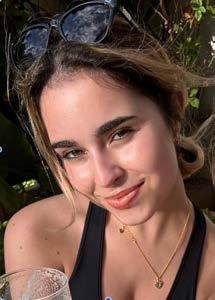
Listening to music on the bus and the people

singing along to it
FAVORITE MEMORIES Our Group
Spending a day with Cuban girls who were the same age as me. It was a transformative experience that allowed me to dive into their rich culture and gain a deeper understanding of their way of life. We shared stories, laughter, and formed friendships that bridged the gap between our different realities. Through our conversations, I discovered the unique hobbies and interests that defined their daily lives. From learning traditional Cuban dances to discussing our aspirations and dreams, the exchange of experiences and perspectives was eye-opening. This memory continues to inspire me to appreciate the diversity of the world and embrace the connections that can be formed across borders.
When I went skinny dipping at midnight in Cienaga de Zapata with all the gals
My conversation with Ailynn, my host sister in Havana, about Cuba's government and the current political economic landscape.



 Chloe Bisaillon
Amalia De Macedo Collins
Sophia El Bakir
Chloe Bisaillon
Amalia De Macedo Collins
Sophia El Bakir
03
Our Group
FAVORITE MEMORIES
My favourite memory is from the theatre in Cienfuegos and when we all did the very spiritual meditation where flowers were put in our hair, then followed by a guitarist playing “Yesterday” by The Beatles, it was very touching. Jordanna’s pregnancy was also pretty funny.






Goingonwalksandvisitingthesurroundingsofourcasas particularesduringourfreetime.AllthetimespentonCalle23 andPaseoinHavana;swimmingunderthestarsinCienagade Zapata,andtowardsthesunthenextmorning;gettingpopcorn andtalkingnexttothewaterinCienfuegos;sittingonabench for2hoursinSantaClaraandpeoplewatching…<3
When the NSS group visited the Alamar farm, and we started the day with a 20-minute weed removal from the Earth. Although it is quite simple, seeing everyone contribute as best as they could, and dig their hands into the bright-red soil, was an amazing and funny sight. Nature things are not my expertise, but I enjoyed the experience!
Spending New Year's Eve in Havana
Olivia Helguero
Mihaela Kasabova
Kitenge Kayembe
Sydney Levitt
04
FAVORITE MEMORIES
Our Group

Making up a choreography and teaching it to the group.
Jordanna Masse


It’stoohardtopickjustone!Iwroteinmyjournalafewdaysafter wearrivedinCubathat“girlsnights,girlswalks,girlsbedroom talks,arekeepingmesomewhatsane.Thereissomuchbeautyin femininityandallthewomenIamsurroundedby.Theirstrength andkindnessprovidemewithenergyandhope.”SoI’dsay somethingI’llneverforgetisthegentlemomentswespenttogether learningabouteachotherandaboutothers.

The Che Guevara monument, as it made me learn more about his life and personality. Much of the information I learned was new to me, which seemed odd to me, given that I felt his larger-than-life status should have made what we learned about him more commonly known. Our tour of the museum within the monument made me reflect on how people who become global icons of his stature are seen more as symbols than as people and tend to, in a sense, lose their humanity in the eyes of society at large, as they are defined less by who they themselves were than what they mean to other people.
 Sebastien Rempel
Lucía Taylor De Leon
Sebastien Rempel
Lucía Taylor De Leon
05
Teachers and guides

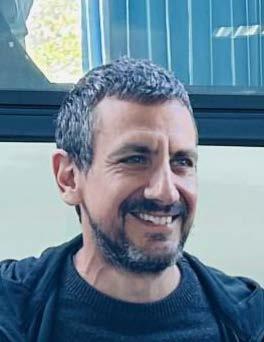

My favourite memory of this trip was visiting the women at the Atelier Atrevete. It was a testament of how we all have something to give and a means to support others. As women share their stories of domestic violence, intertwined with their aspirations for their lives, they extend a hand to others in their community, creating a chain of solidarity and community.

Seeing Sandor, Edelso and Chino reconnect along the way with people they hadn't seen for three years because of the pandemic. In particular, on the first evening in Puerto Esperenza, we watched a youth dance performance, and it was really meaningful to learn that our guides knew these young people well and had seen them grow up over the years. It felt good to know that our visit was also a reason for our guides to reconnect with their communities.
One of my favourite memories is a night in Puerto Esparanza, on the farm, after we had finished dinner and the sun had gone down. Under the gazebos some people were playing cards, some people were dancing, and we were deep in conversation with Sandor, Edelso, and Chino, at once silly and serious, trying to make sense of the world and its injustices.
Without whom, this trip would have never been possible or this memorable...



 Sara Kendall
Mark Beauchamp
Gisela Frias
Sandor
Tour guide
Chino
Bus driver
Edelso Translator
Sara Kendall
Mark Beauchamp
Gisela Frias
Sandor
Tour guide
Chino
Bus driver
Edelso Translator
06


03
DANCE AND ENGLISH CLASSES


WHAT IS IT?
We were granted the opportunity to participate in an enriching cultural exchange with youth from the CMMLK. Most were part of the Cabuya Dance Company, with Yordellan Tellez as the director, and teacher. They taught us dance, and we gave English lessons.Eachperformanceconveyeditsownmessage thatpushedusintoreflection.

ART AS A UNIVERSAL LANGUAGE
The fundamental ability for humans to communicate is often associated with language and the need to have that basis to interact with one another. However, this fascinating time spent inthecompanyofthedancetroupeattheCMMLK shed light on the ability to convey oneself through other art forms and on the value of creativity and artistic expression in society. Through movement, vulnerability, and touch, a wordless dialogue formeditself
BEYOND CULTURAL DIFFERENCES
Similarly,ourfirstdancelessonwashowtodanceson, which was a culture shock for many of us. However, a big component of field experience has been adapting to, acknowledging, and accepting discrepancies in culture. As we began to understand the way dance fosters a sense of community and belonging to them, we began to adapt what they knew and loved into our wayofexchangingwithdancersfromCabuya.
08
What is it?
This memorial aims to denounce American Imperialism and honors the victims of terrorist attacks that were organized against Cuba. The tour guide provided information about the history of relations between Cuba and the United States, the various types of terrorist attacks (bombings, sabotage, assassinations, warfare, etc.) as well as numerous forms of state violence, such as military, economic and psychological violence.
MEMORIAL DE LA DENUNCIA Art
Documents such as authentic artifacts, photographs, videos and artistic depictions of the violence emphasized the resistance and the extent of the atrocities that occurred. Moreover, the art in the memorial provides a more general representation of how Cubans use art as a means of self-expression for various issues. For instance, one of the art pieces featured two parallel walls of faces. On one side the American enemies were depicted in red and on the other the Cuban state in blue, a way of using art to depict the intense nationalism within the country that is used to inspire hope and resilience.



09
A LOOK AT HISTORY
RACE ISSUES
INTRODUCTION
The country's complicated colonial relationship and thus its combination of ethnic backgrounds-Spanish, African, and Indigenous-- has resulted in a nonhomogeneouspopulation.AndyetIhad felt like race and racism hadn’t been mentioned much in many of the other conferences we had, considering how much of an impact race can have on one’s life. Aracelis Rodriguez Malagón cameandspoketousassomeonewho has researched on Black women feminism.
She explained that Cuba, like other countries in the Caribbean, was a plantation economy, sustained by the enslavement of Afrians. In this period of colonialism,therewasneverapacificway of living; there were several organized rebellions,ledbyBlackmenandwomen, as well as rebellions through the use of literature. Unlike in North America, these colonies were allowed to keep their culture. Places in which Black people gathered for festivities and religion were also spaces for interchanging culture and educating,whichwouldbecomesocieties of Black and Mulatto persons. Printing laws of the type allowed Black women to freely express their struggles and publish theminmagazinessuchas Minerva.
STEPS FORWARD
Studies showed that poverty indicators weremostlyinBlackmenandwomen.As a result, racial debates started emerging in congresses, and intellectuals took advantage of Fidel's attendance to publiclyexpresstheirviews.Itisessential to understand the history of racism in Cuba to address it effectively and promoteaninclusivesociety.



10
ATELIER ATREVETE
WHAT IS IT?
TheAtelierisacenterforwomenwhohavelived throughdomesticabuseandarenowtryingto getbackontheirfeet.Itsgoalsaretosupport eachotherandtomakemoneythusgaining financialindependencethatisneededtofight thepatriarchy.Moreover,theworkshopcenters aroundanideathatcannoteasilybefoundin capitalistcountries:popularsolidarityeconomy.
EDUCATION
Education plays a fundamental role within this project. These women have delivered workshops on domestic violence and how to battle it in every municipality of Havana. They utilize education as a form of preventative care as they aim to limit cases of abuse by educating the younger population.


POPULAR SOLIDARITY ECONOMY
A popular or solidarity economy is a “business” that stems from people who work to benefit the collective community. People pay what they can, and if they cannot afford the services, payment isn't necessary. If someone in the community is in trouble, the community will help them. This popular economy, though it has the word “economy” in it which is often associated with money, seems to be much more axed on collaboration and unity. That is a very powerful ideal, as it portrays that an alternative system is possible.
THE SEWING WORKSHOP DEPICTED THE STRONG SENSE OF COOPERATION THAT EXISTS AMONGST WOMEN IN CUBA.
11
- Sophia
ALAMAR
WHAT IS IT?
Vivero Alamar is an organic farm or organopónico located in the Alamar municipality of Havana. They use natural fertilizers to grow crops, grease up coloured plaques that attract bugs and make them stick, use natural fungicides like lime, grow plant repellents such as marigold and oregano that emit unpleasant smellsforinsects,nurturehealthycompost,etc.
ROLE IN THE COMMUNITY
We discussed the population’s response regarding the sudden shift in agricultural practices of the 1990s caused by the collapse of the Soviet Union. The guide told us about the current crisis that strongly affected the food safety net of Cuba. He described Vivero Alamar’s role in the food chain in which they provide as much as possible directly to the population. Moreover, this organopónico’s objective is also to provide produce in line with the community’s needs. For example, one year they grew more iron-rich foods such as spinach for the maternity center nearby that required it.
THIS WAS (QUITE LITERALLY) A VERY DOWN-TO-EARTH EXPERIENCE WHERE WE GOT TO LEARN ABOUT THE SKILLFUL WORK OF THE FARMER [WHO] PRODUCES HEALTHY AND FRESH FRUITS AND VEGETABLES FOR THE SURROUNDING COMMUNITIES


 - Amalia
- Amalia
12
EL MURALEANDO
WHAT IS IT?
ITS SIGNIFICANCE TODAY
Today, the art project serves mostly for the youth around the area, providing them with free access to art classes and materials. Most of the funds are obtained from art purchasesmadebythepublic.Whenanart piece is sold, fifty percent of the sale goes to the artist, and the remaining fifty percent is placed into the children’s funds, to buy artsuppliesandextramaterialsforthem..

El Muraleando is an art project that transformedawasteland,intoacommunity art center. Indeed, prior to its embellishment, the site used to be a water tank and a garbage deposit lot for the community. However, local artists saw beyond; the potential that the area had pushed them to buy the lot and repurpose it. From almost all the pieces of garbage came a beautiful art piece or furniture. A genuine involvement in the building of the Muraleando brought government attention, becauseoftheingenuityofthecommunity.
OBSERVATION
One memorable thing about the Muraleando is the implication of the community. The people that received us each had careers in domains unrelated to art, but they spaced out time to be there, and make art, for the youth’sbenefit.



13
ORGANIZACION OSCAR AMULFO ROMERO
FUN FACT
WHAT IS IT?
The foundation helps women in abusive situations, as well as informs the community on domestic violence and sexism. There are psychologists and social workers to support women. They will talk to the family, offer her resources, etc. They also do national campaigns to educate the public, including this conference, because often violence against women stays silent.
The sexism in Cuba manifests differently than in Canada. Most of the workers in the field of health are women (so doctors, nurses, surgeons, etc.) which is not the case in Canada. Nonetheless, they still are overburdened, as they're often expected to take care of family in addition to having a job.

IT WAS INTERESTING TO FIND OUU THAT THE FOUNDATION HAD A RELIGIOUS COMPONENT. THE CHURCH HAD AN INFLUENCED ON THE THEMES AND THE WAY THEY APPROACHED THESE ISSUES IN A PROGRESSIVE MANNER.

14
- Anonymous


La Camorra
WHAT IS IT?


Being a local art group that unites members of the small community of Puerto Esperanza, la Camorra is a great example of an initiative that emphasizes the cultural and personal, artistic expressions of Cubans.Theywereabletoperformwhatsomemay call miracles with very limited access to resources. What was striking about our first encounter with them was how they intertwined emotional connections with their shows or dance demonstrations. They were dancing with the purpose of conveying a message, whether it be political,social,etc.

ENVIRONMENT
LaCamorraalsoraisesawarenessbyteaching topicsrelatedtoviolenceagainstwomen,and homophobiatoincreasethesenseofopenmindednessandsolidarityamongthecommunity,in additiontotopicsofenvironmentalawareness.
THEY SEEMED VERY HAPPY AND GRATEFUL TO WELCOME US, WHICH CREATED, FROM THE VERY BEGINNING, A SENSE OF COMMUNITY AND SOLIDARITY BETWEEN THE MEMBERS OF THEIR GROUP AND US, WHO WERE VISITORS TO THE AREA FOR A COUPLE OF DAYS.

-
16
Rosalie
What is it?
Viñales is one of the most significant tobacco-growing regions in the world. At this farm, we learned about the way tobacco plants are grown and harvested by farmers calledTorcedores.



Theleavesareharvestedinstagesastheymature,asthe art of making a cigar is intricate as demands a great deal of knowledge and talent. The leaves are meticulously cured after they are collected in order to enhance their distinct flavour and scent, as each leaf has a particular taste. For instance, the farmers regularly circulate throughout the farm to move every plant leaf as the sun alters the taste and the leaves that receive less sunlight taste weaker. Afterwards, the Torcedores process the tobacco leaves and roll them into cigars. We also went horsebackriding!
Tobacco Farm
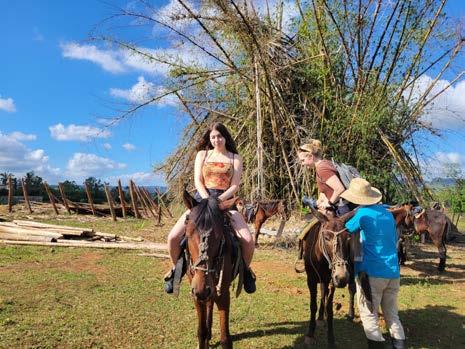
In comparison to Western Models
Within the mass production of goods, the quality of products is often sacrificed so the cheapest product possible is sold to consumers. Meanwhile, this tobacco farm represents a stark contrast to that method of production, as everything is hand-made to ensure quality. Moreover, the center of this mass production is competition;competitionforwhocangetthelowestprices and make the most profits. However, rather than focusing on competition, these tobacco farmers focus on collaborationandworkingtogetherwhichissymbolicofthe general absence of Western capitalism. Moreover, this focusoncollaborationwasomnipresentinCuba.
.
17
Comite De la Defensia de la Revolucion (CDR)

The CDRs were first created after the Revolution to dismiss people with negative intentions and uphold the core socialist values of the Revolution. But it morphed, through community involvement, implication inschoolsandeducation.TheCDRsmaintain organized communities and provide support for them. For example, they distributed vaccines, and participate in food production and recycling, with their goal being the enlightenment and betterment of the population.
TheirworkhasbenefitedmanyCubancommunities andfamilies,whilekeepingtheirgoal.Theyhave strivedandsupportedwomen’spresenceinpolitical affairs,atlocalandprovinciallevels.Indeed,the CDRchapterthatwevisitedhasamajorityofwomen asitsmembers,butmorethanthat,theleadership positionswereheldprimarilybywomen.


THE SPEAKER SAID SOMETHING ALONG THE LINES OF:
“TO GIVE OUR HEARTS, AND NOT OUR SURPLUS” WHICH I HAVE OFTEN SEEN IN SOCIETIES OF THE GLOBAL NORTH. OFTEN, WE GIVE OUR SURPLUS OF MATERIAL OR FOOD TO THOSE IN NEED. AS AN INDIVIDUAL, IT IS OFTEN TO THOSE IN SITUATIONS OF HOMELESSNESS, AND AS A SOCIETY, WE OFTEN GIVE OUR SURPLUS TO CHARITIES, FOOD BANKS AND OTHER ORGANIZATIONS. THE CDR, HOWEVER, THEY INTENTIONALLY GAVE THEIR PRODUCTIONS AND SERVICES TO THE COMMUNITIES, AND NOT JUST LEFTOVERS
-
18
Kitenge


ORIGINS OF THE BIOSPHERE RESERVE


WHAT IS IT?
Upon arrival in the Bay of Pigs, we met with a specialist who enlightened us on the origins of the biosphere reserve and socio geographical characteristics of the area. The conference was engrossing due to the framework created by the specialist that focuses on getting us to question certain aspects, such as the lack of insect study, or the effects of tourism on tourism.


TOURISM KILLS TOURISM
Bay of Pigs and the rest of Cuba infringes on the ecosystem that lies underneath it. The revolutionary government developed social services in the area by expandingthecreationofnewbuildingstoweringover the ecosystems that makes the zone so incredibly attractive to foreigners. The large sum of income generatedbyBayofPigsderivesfrompeoplecoming to view the unique components of its biosphere. However,themorepeoplethatusetheseservicesand cross these bridges, the more the ecosystem degrades, hence explaining how tourism kills tourism, the line of the entire presentation that was the absoluteclimax.
REFLECTION
The lack of research on bugs plays to the lack of interest in what is small. However, size should not cause neglect. In fact, according to the speaker, insects play huge roles in the ecosystem of the area and its functioning. This grander conception of keeping an eye out for more minuscule components of Cuban life and culture was taken from this insect-oriented discussion and noticing them became an ultimate practice on the trip.
20
Bay of Pigs museum

At the museum, our guide explained the events which occurred in the lead-up to and during the Bay of Pigs invasion. This attempted invasion was carried out with an army of mercenaries deployed by the government of the United States and American intelligence agencies in April 1961. These forces aimed to overthrow the nation’s communist government as it hindered the ability of American corporations to exploit Cuba in the two years since it had come to power. In describing the Bay of Pigs invasion, our guide at the museum talked about incidents which occurred prior to the landing at the Bay of Pigs. This included bombings in the port of Havana carried out by the United States as well as attempts made to assassinate Fidel Castro, the long-time leader of Cuba.
The strong nationalism present throughout the country was particularly prevalent in the museum which explores the sentiment as a means of defence against exploitation. In addition to learning about the Bay of Pigs invasion through the information presented, the artifacts from the time of the incident were displayed in the museum. Among these artifacts were pictures of Cubans who died defending their country’s political independence at Playa Girón in the spring of 1961. These photos made the human cost of American imperialism feel less abstract and provided a stark and harrowing example of the pain that Cuba and its people have had to endure because their natural resources have been the target of foreign colonialists.

21
POLICLINICO

Edelso explaining how the clinic works and their innovations.
The polyclinic in Cienaga de Zapata is a testament of Cuba's priorities and values. Contrary to many healthcare systems in the Global North, the polyclinic is free of charge for everyone as they not only view healthcare as a fundamental need but also as a right.

Moreover, the system as a whole emphasized solidarity. For instance, prospective medical students are all required to spend time in their municipality learning and understanding the needs of their community. Moreover, since they have a high number of doctors they lend help outside of their borders to foster international solidarity. However, they also have a mechanism in place to ensure that whoever is leaving for international medical services is not needed in the community first. This is all demonstrative of Cuba’s commitment to solidarity both internally and externally.
Nevertheless, it cannot be denied that they are experiencing certain shortages because of the embargo that the United States imposed on them. The blockade implies that they are cut off from a significant part of international markets, making material goods extremely difficult to access. Meaning, the American government is not punishing the Cuban State, but the people as they are hindering their access to fundamental services. It is them who can no longer procure surgical thread and save lives with it; who do not have the engines to build ambulances and rush people in need of emergency care to hospitals.
22
CIENFUEGOS and Santa clara

Teatro De Los Elementos
We were greeted by José Oriol Gonzalez, the founder of the Teatro de Los Elementos. The visit started with a compelling introduction to the theatre company’s beginnings and current objectives. After being an itinerant theatre company for many years, this theatre is now a stable artistic community situated near Cienfuegos which are recognized internationally fortheirtalentandinfluence.Thisorganizationis also recognized for their community engagement and different socially relevant projects directed at various communities in Cuba.Theytoldusaboutthestoryofcoffee.
PlaybackTheatre







Wetoldtheactorsafewstoriesand theybrilliantlyre-enactedthem. Thisvisitgaveusagreatpeekinto therichCubanartandtheater scene.

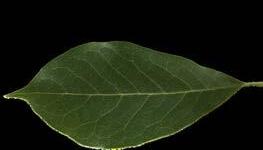
The two actors sang us an enchanting melody while walking around us, creating a magical and hypnotic atmosphere. While they sang and walked around us, they placed a flower in our hands, hair or behind our ears. As we opened our eyes, the energy had shifted, and everyone was suddenly a lot more present and mindful of ourpresenceinthespacesurroundingus.
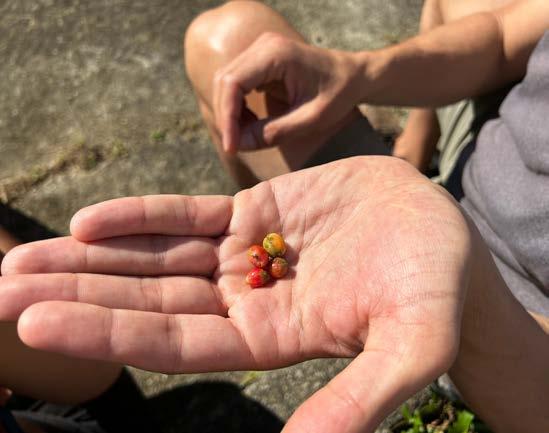
24
El Mejunje
WHAT IS IT?
El Mejunje is a very popular bar club that prides itself on inclusivity. Silverio, the owner and founder of the bar, told us how he built this place as a haven for members of marginalized groups, such as the LGBTQ+ community. What is so special about this place is that no matter where you are from, what you look like, what your rank is, you will always be treated equally. It is a true celebration of diversity.
DURING CRISIS
El Mejunje also becomes a center of mobilization during times of hardship such as the aftermath of a hurricane or the Covid-19 pandemic. They gather donations of necessities from ordinary people and households, then distribute these resources to those who need them.

IT WAS NAMED AFTER A MEDICINAL DRINK THAT COMBINE A BUNCH OF HEALING PLANTS AND INGREDIENTS TO HEAL PEOPLE. IT IS A METAPHOR FOR THE PEOPLE OF THIS BAR. THEY ARE A MIX OF ETHNICITIES, LANGUAGES, SEXUAL ORIENTATION AND THEIR TOGETHER-NESS HEALS THE COMMUNITY



- Anonymous 25
Che Guevara Memorial Museum


WHAT IS IT ?
The museum took an autobiographical approach to Guevara’s life and showed many objects from his childhood moving along to his adulthood and death. His remains are partially there within a crypt alongside those who fought with him in Bolivia. Within the crypt,thereisaneternalflamemadetorepresenttheeternalnatureofthemessageshe spread throughout his life and his eternal legacy. Facing the south, a large statue of Guevara is observed within the memorial, depicting his heroic nature. The memorial depicts the idea of Che Guevara as a national hero, as a symbol of hope and mobilizationthroughoutCubanhistory.
REFLECTION
Che’simportanceisheldinthefactthathewasseenas such a threat by the Americans; they saw him as a force that can subvert their domineering power and exploitation over Latin America. However, the memorial argues against that narrative, that Latin Americaisnotpowerless,despitetheUnitedStates’.

26
Homestays throughout the trip


Essence
The objective of the homestays was to be immersed in a Cuban household and therefore surrounded by Cuban Culture. Through those experiences, we were able to live an approximate, more realistic and unfiltered Cuban life.



What we did
We ate traditional Cuban meals, and learned about the life of our host families. Though our host families also “beautified” our meals, most of the time, they were completely honest about the privileges we had as tourists, and how certain items were almost impossible to have daily.
Reflections
We were able to learn about different traditions, as well as the local struggles of the families that hosted us. The beauty, and the challenge of the homestays, was the lack of oversight; the other activities that we had were all guided by our teachers and guide, and we, the students, kept in mind that the teachers could help us if we felt stuck, in language for example. The homestays, however, placed us in autonomy mode, allowing us to be completelyindependent.
27
And so many more places and conferences...
Family Code
We learned about its relationship with the Constitution and the ways in which both have changed in the past 40-50 years. The 2022 Family Code emphasizes on the construction of a country as a community, and positions relationships and ties of affection above blood relations. The new 2019 constitution now includes a chapter on families, and follows a principle of non-discrimination due to sexual orientation or gender identity. It's important to note that the 1975 Family Code was considered advanced for its time, but the current Family Code is now officially the most advanced in all of Latin America.
Felix Varela Foundation



Jorge Davis gave us a detailed presentation on the balance between what you take and what you restore to a given system in order to maintain and ensure sustainability between ecosystems. The lesson was that we can use the resources but not overuse them and must learn how to properly use and restore them. Their project aims to educate the youth and the people.

Fabrica de Arte Elementary school in Cienfuegos


We were exposed to so many different types of art, music, dance. It was a taste of the Cuban nightlife.
We learned about the values of the education system: equality, patriotism, community; how schools function

28






















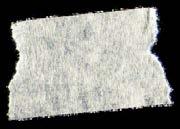


aesthetics 29
FOOD
BeachDays
















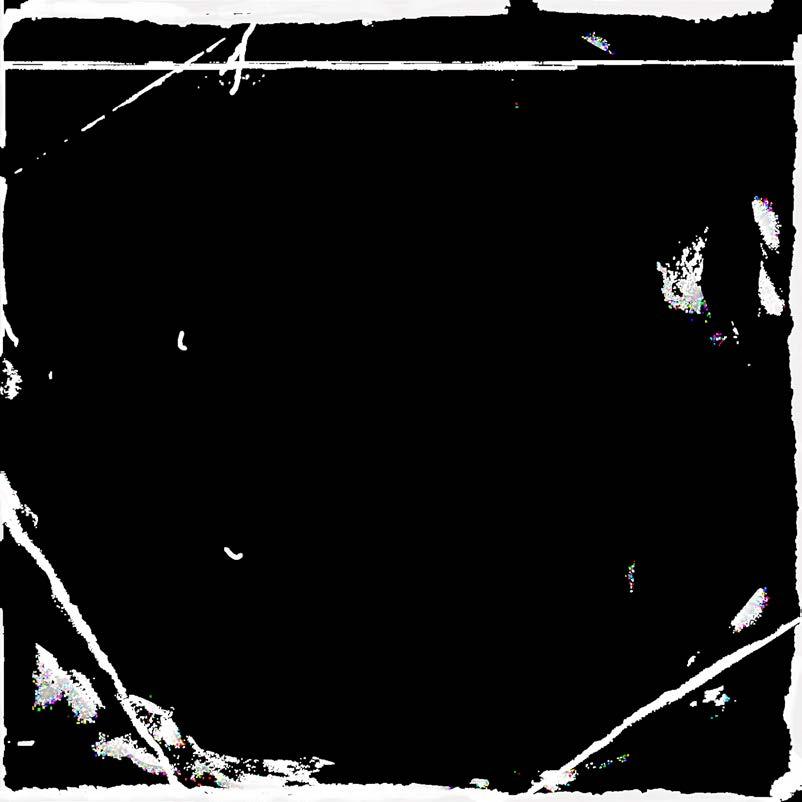




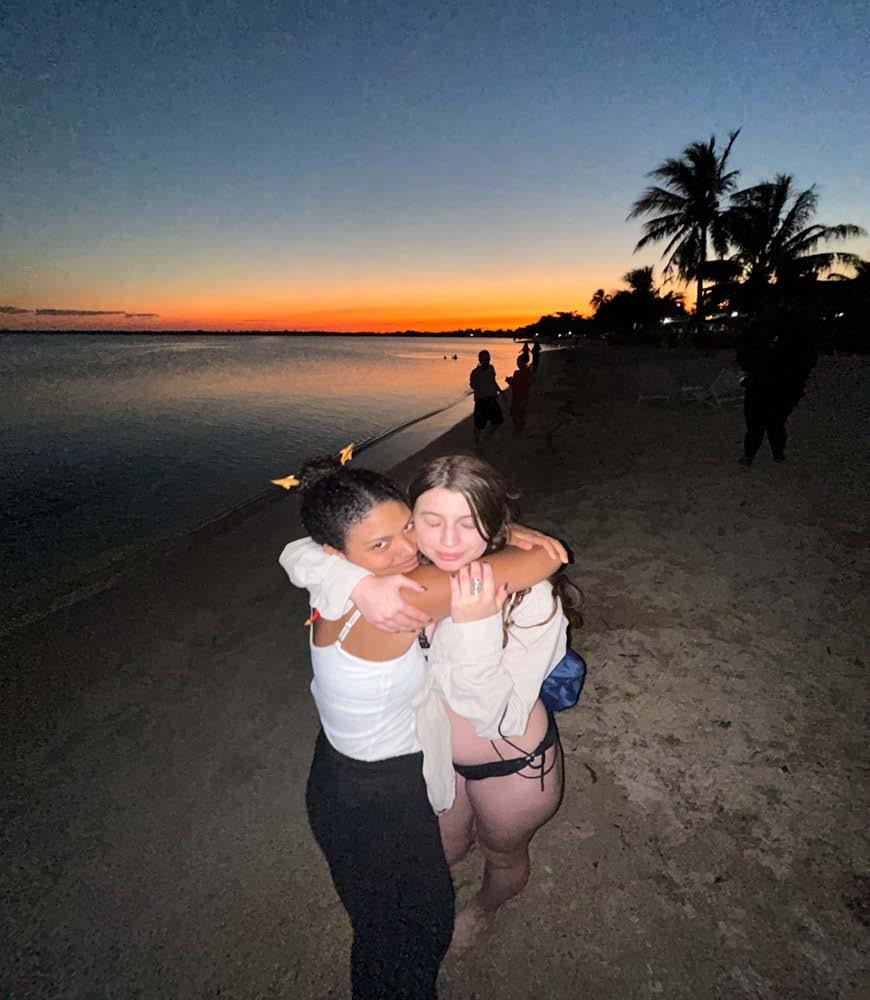
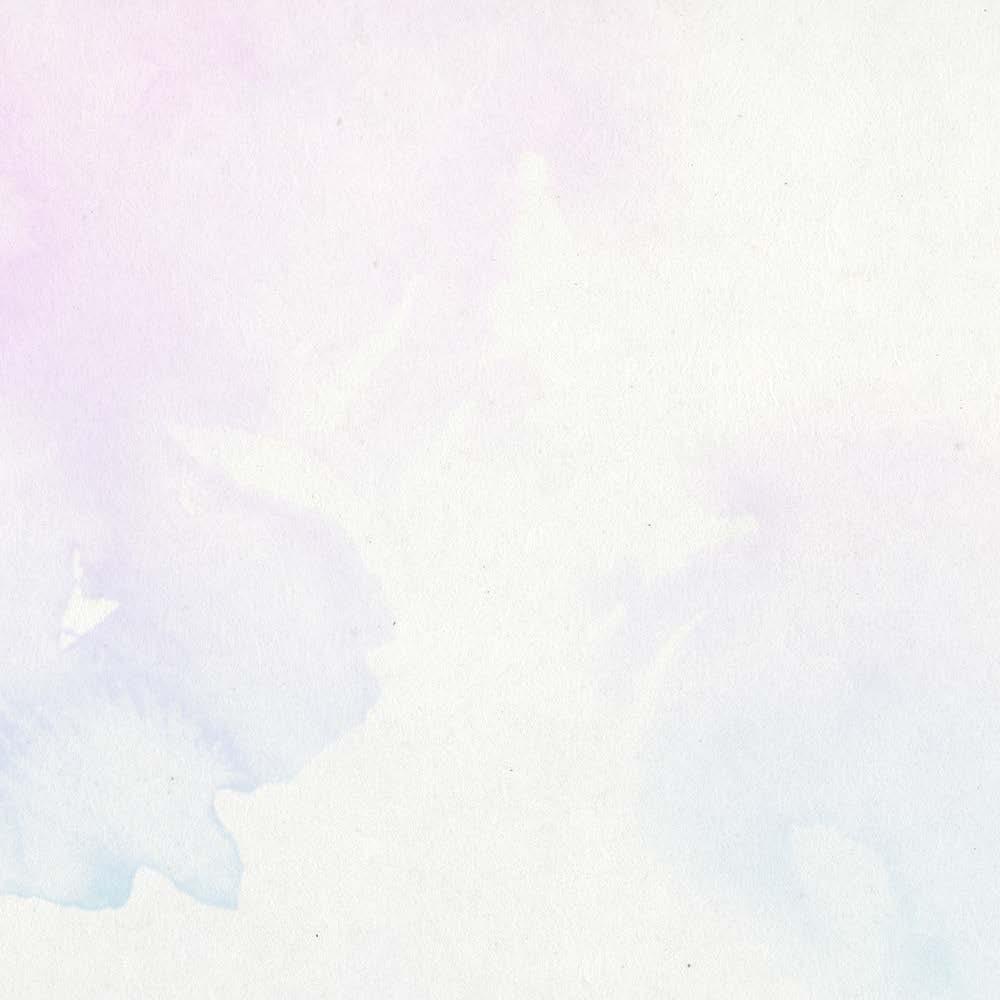
30
CityLife











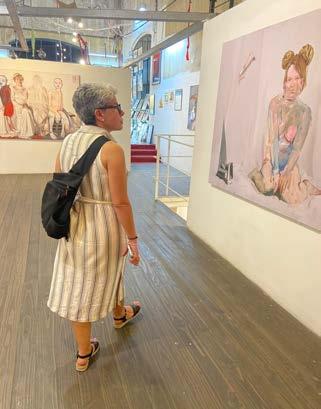

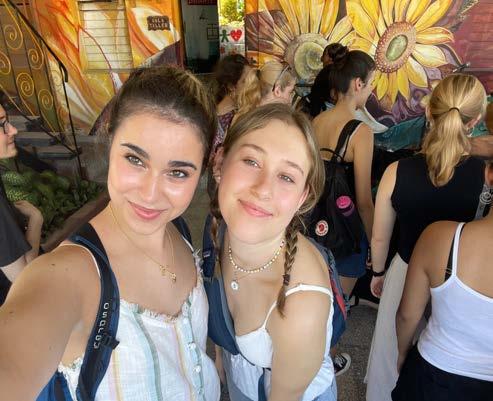








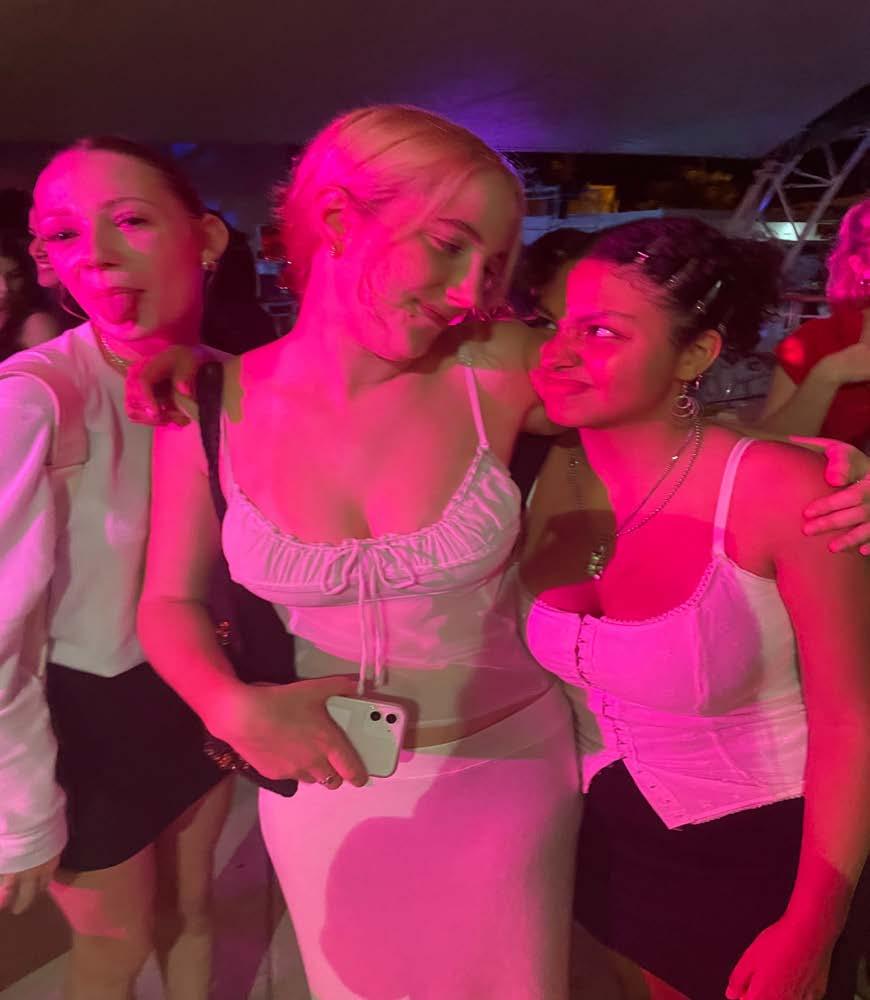
Hike








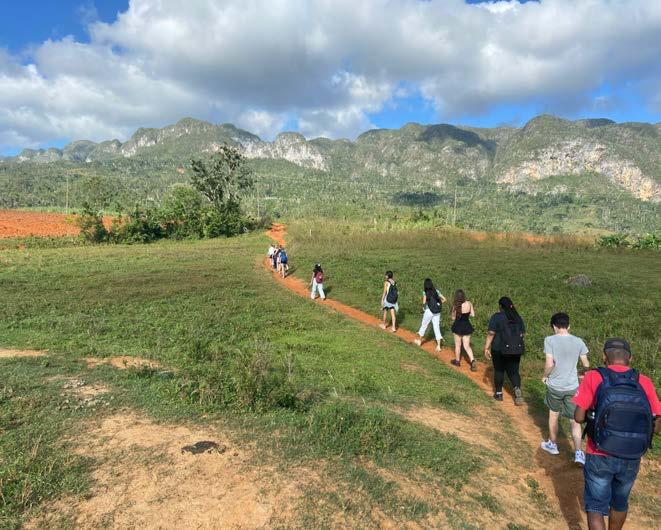

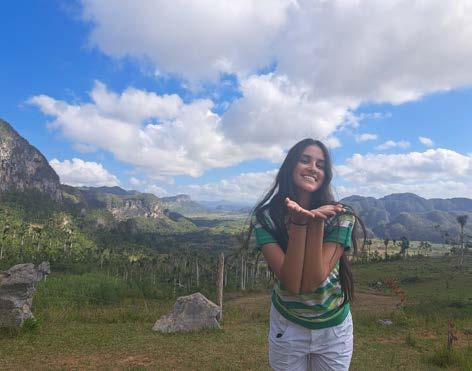











32
A life changing experience
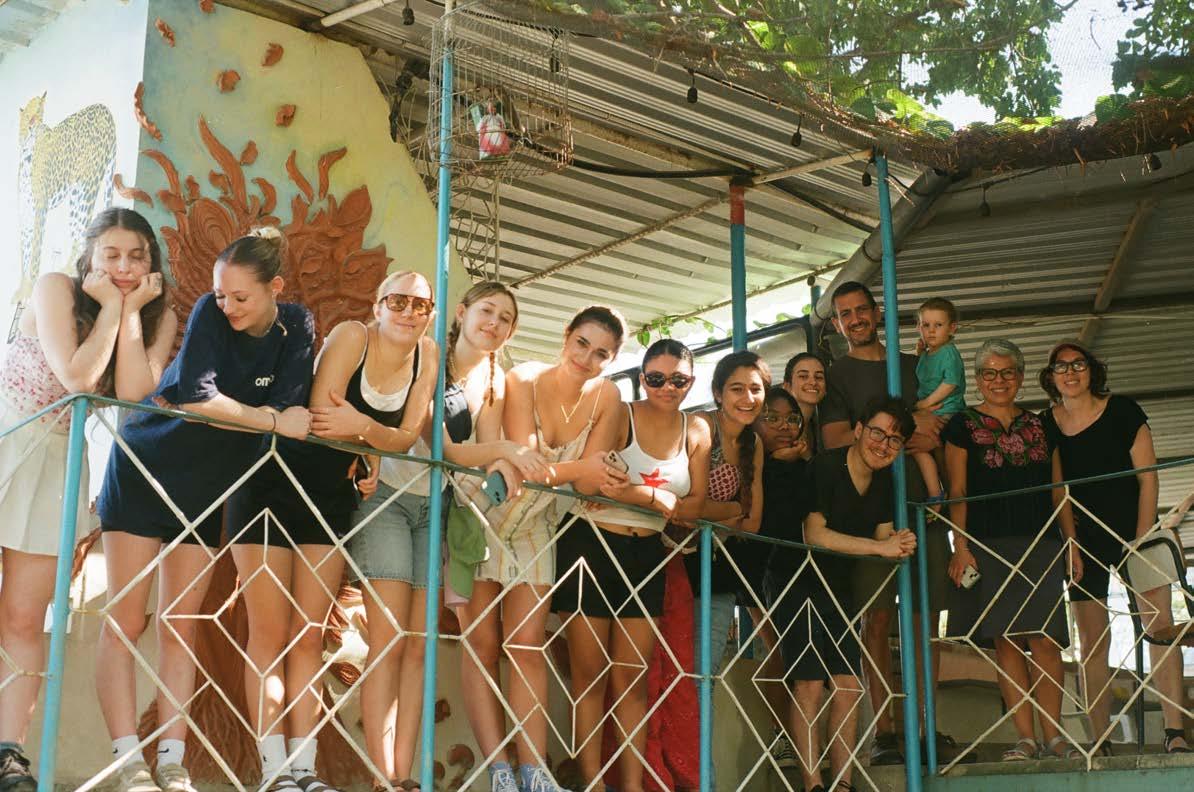

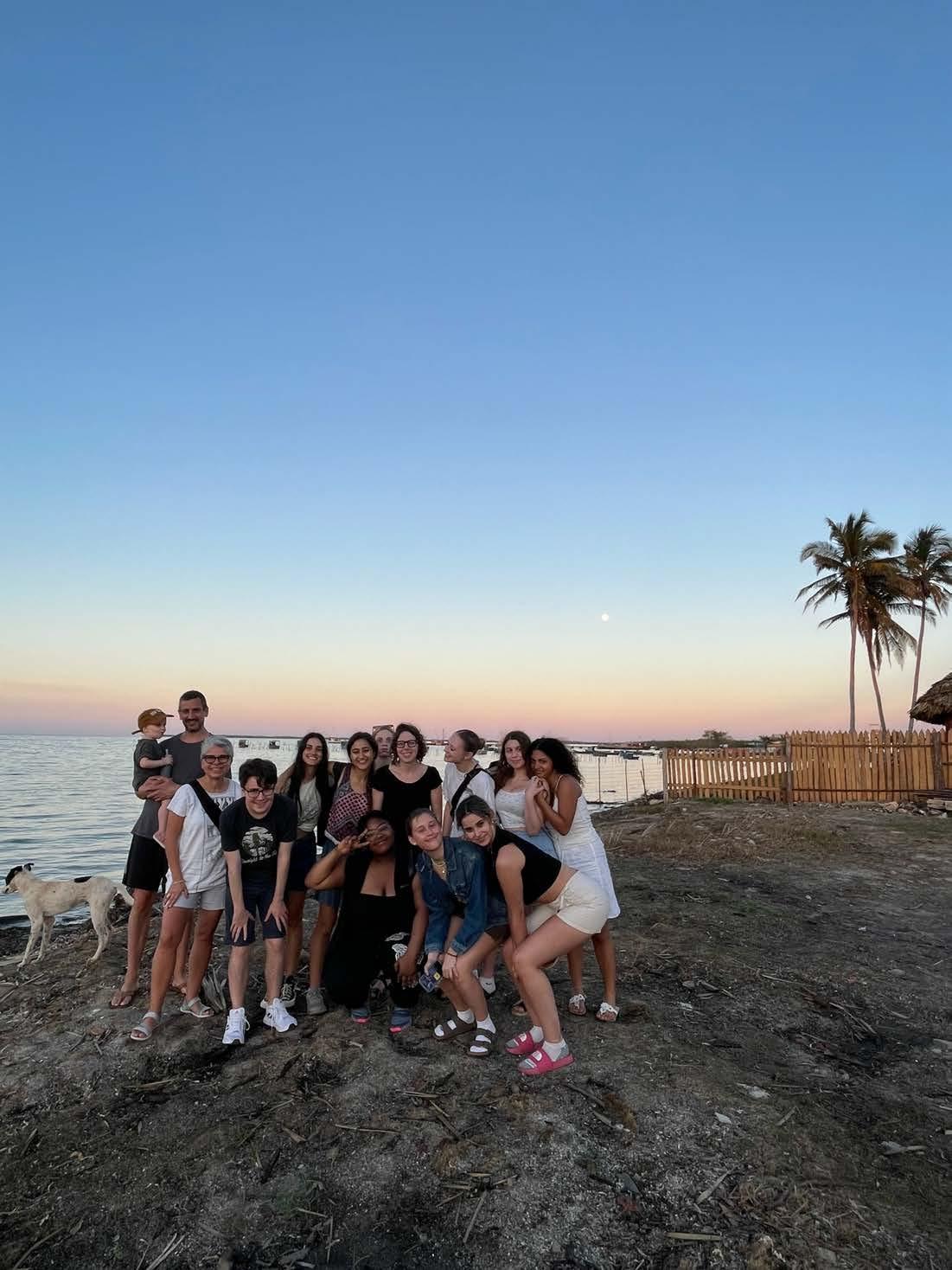














 Chloe Bisaillon
Amalia De Macedo Collins
Sophia El Bakir
Chloe Bisaillon
Amalia De Macedo Collins
Sophia El Bakir






























 - Amalia
- Amalia


































































































































